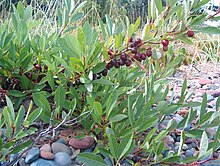Prunus pumila
| Prunus pumila | |
|---|---|
 | |
| Fruit in late July. | |
| Scientific classification | |
| Kingdom: | Plantae |
| Clade: | Tracheophytes |
| Clade: | Angiosperms |
| Clade: | Eudicots |
| Clade: | Rosids |
| Order: | Rosales |
| Family: | Rosaceae |
| Genus: | Prunus |
| Subgenus: | Prunus subg. Prunus |
| Species: | P. pumila |
| Binomial name | |
| Prunus pumila | |
| Synonyms[1][2] | |
| List
| |
Prunus pumila, commonly called sand cherry, is a North American species of cherry in the rose family. It is widespread in eastern and central Canada from New Brunswick west to Saskatchewan and the northern United States from Maine to Montana, south as far as Colorado, Kansas, Indiana, and Virginia, with a few isolated populations in Tennessee and Utah.[1][3] It grows in sandy locations such as shorelines and dunes.[4]
Prunus pumila is a deciduous shrub that grows to 0.61–1.83 metres (2–6 feet) tall depending on the variety.[5] It forms dense clonal colonies by sprouts from the root system. The leaves are leathery, 4–7 centimetres (1+5⁄8–2+3⁄4 inches) long, with a serrated margin. The flowers are 15–25 millimetres (9⁄16–1 in) in diameter with five white petals and 25–30 stamens. They are produced in small clusters of two to four. The fruit is a small cherry 13–15 mm (1⁄2–9⁄16 in) in diameter, ripening to dark purple in early summer.[6][7][8]
- Prunus pumila var. besseyi (Bailey) Gleason, western sand cherry (also called Rocky Mountain cherry) – Saskatchewan, Manitoba, western Ontario, south to Colorado and Kansas
- Prunus pumila var. depressa (Pursh) Gleason, eastern sand cherry – Ontario, Québec, New Brunswick south to Pennsylvania
- Prunus pumila var. pumila, Great Lakes sand cherry – shores of Great Lakes
- Prunus pumila var. susquehanae (hort. ex Willd.) Jaeger, Susquehana sand cherry – from Manitoba east to Maine, south to Tennessee
- Prunus × cistena (purple leaf sand cherry) is a hybrid of Prunus cerasifera (cherry plum) and P. pumila.[10] It was developed by Niels Ebbesen Hansen of South Dakota State University in 1910.[11] They grow to be about 2.1 m (7 ft) tall and can live for up to 20 years.[12]
Gallery
[edit]- P. pumila var. depressa in bloom
- P. pumila var. pumila just after flowering, in June
- Mature flowers
- Cherries (mostly unripe) growing on branches
- Close-up of leaves
References
[edit]- ^ a b "Prunus pumila". Germplasm Resources Information Network. Agricultural Research Service, United States Department of Agriculture. Retrieved 2 January 2018.
- ^ The Plant List, Prunus pumila L.
- ^ Biota of North America Program 2014 county distribution map
- ^ "Prunus pumila".
- ^ "Susquehana Sand Cherry (Prunus pumila susquehanae)".
- ^ "Prunus pumila Sand Cherry". Montana Field Guides.
- ^ Huxley, A., ed. (1992). New RHS Dictionary of Gardening. Macmillan ISBN 0-333-47494-5.
- ^ a b Flora of North America, Prunus pumila Linnaeus, 1767. Sandcherry, cerisier des sables
- ^ United States Department of Agriculture, National Forest Service
- ^ Plant Facts, Prunus x cistena - Purpleleaf Sand Cherry (Rosaceae)
- ^ Nazareth College, Purpleleaf Sand Cherry Prunus x cistena Archived 2016-03-06 at the Wayback Machine/
- ^ "Purpleleaf Sandcherry (Prunus x cistena) at Connon Nurseries". Connon Nurseries Plant Finder. Retrieved 2020-03-19.


 French
French Deutsch
Deutsch




